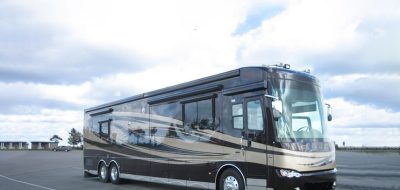The tiny town of Ajo (ahh-ho) is situated deep in the Sonoran Desert, 42 miles south of Gila Bend and 37 miles north of the Mexican border. For many snowbirds, as it was for us, Ajo is merely a stopping-off point on the way to Organ Pipe Cactus National Monument. For others, especially Spring Breakers, it’s a town to pass through on their way to Puerto Penasco (Rocky Point).
However, Ajo just might be the “best kept secret in Arizona.” This is the place where the “Summer spends the Winter”, according to the local Chamber of Commerce.
The town of Ajo reflects its one time wealth to this day. Glistening white churches and a well-designed plaza are so inviting.
Ajo today is a retirement community and snowbird haven along with an increasing number of artists. Ajo’s gorgeous mountain views and charming Old World architecture are enchanting and we soon fell in love with this friendly community in southwestern Arizona.
Ajo got its name from a poor Spanish translation of an Indian word. To make body paint, the local O’odham Indians used copper. Their word for paint was aau’auho, which sounded to the Spanish like the familiar word ajo, meaning garlic in their language. Later, the wild lily plants in the area were named ajo for the flavorful bulb at its roots.
But copper has provided the sinew for this desert town for about 300 years. Ajo was the oldest-known mine site in the state, and until the 1980s Phelps Dodge ran a sizable copper mining operation out of here.

Across the street from the plaza are two stunningly beautiful churches—a mission-style Catholic church constructed in 1924 and a Federated church built in 1926. © Rex Vogel, all rights reserved
The mines originally were made profitable during World War I by John C. Freeway, who also gets the credit for building the town’s palm tree-shaded Spanish Colonial Plaza in Ajo’s center. The plaza is a traditional town square with Spanish Colonial Revival porticoes to keep the sun from invading the post office, the library, the former railway station, and a couple of shops and restaurants. In the midst of the plaza is a large, green park. Across the street from the plaza are two stunningly beautiful churches—a mission-style Catholic church constructed in 1924 and a Federated church built in 1926.
Ajo was the birthplace of copper mining in Arizona. In the 1700s, the Spanish dug a 60-foot mine to extract copper ore before moving on. The next major activity occurred in 1854, the year the Gadsden Purchase was ratified and made the area part of the United States. But that venture failed because the mine owners had to ship the ore to Wales for smelting, and the ship carrying the second load of ore sank, which bankrupted the company.
After several other attempts at mining the low-grade copper ore failed, a new sulfuric acid leaching process made the cost of extracting the ore profitable in 1916, and Ajo’s mining boom was under way, producing hundreds of millions of tons of milling ore.
Phelps Dodge Corp., present owner of the mine, mothballed it in the middle 1980s. But the vast reserves of copper remaining in the ground at Ajo no doubt mean the mine has not seen the end of its days.

Porticoes of the former train station front one side of the town plaza. © Rex Vogel, all rights reserved
A number of the buildings from the 1920s and before are still standing. Curley School, southwest of the plaza on Vanand, was constructed in 1919. The Train Depot directly northeast of the plaza dates from 1915. New Cornelia Hotel just east of Curley School was constructed in 1916.
A few miles further, past loads of cacti, long hills of white sediment and stretches of crushed stones in multicolors line the highway, left by the New Cornelia Copper Mine.
At one time this was the third largest copper mine in the U. S. It was named after the wife of John Bode who helped the promoter A.J. Shotwell set up the St. Louis Copper Company in 1890.
As a company town, it was attractively laid out by an architect and built in 1916-17.
Among progressive industrialists of the day, such garden cities were in vogue for their workers, and Ajo was nationally noted as the first in Arizona. Still, though the immense open-pit mine is closed, the town plaza remains grand to this day.
Worth Pondering…
The vast emptiness and overpowering silence of the desert and surrounding mountains sharpens your senses, enhancing self-contemplation, and stimulating creativity.
You May Also Like
- Playing in Mute Harmony: Organ Pipe Cactus National Monument, AZ
- 3,800-acre Rancho Corral de Tierra Transferred to Golden Gate National Recreation Area
- Name Change Proposed for Ross Lake National Recreation Area
- Whooping Crane Arrival at Aransas National Wildlife Refuge
- Whooping Cranes Wintering in North Carolina
- RVs That Double as Ice Fishing Cabins
If you enjoy these articles and want to read more on RV travels and lifestyle, visit my website: Vogel Talks RVing.







